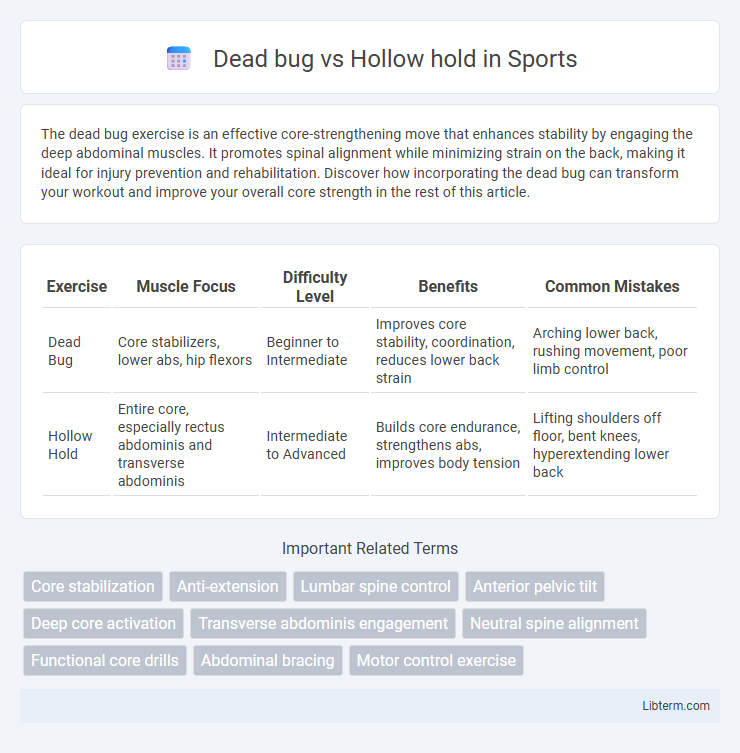The dead bug exercise is an effective core-strengthening move that enhances stability by engaging the deep abdominal muscles. It promotes spinal alignment while minimizing strain on the back, making it ideal for injury prevention and rehabilitation. Discover how incorporating the dead bug can transform your workout and improve your overall core strength in the rest of this article.
Table of Comparison
| Exercise | Muscle Focus | Difficulty Level | Benefits | Common Mistakes |
|---|---|---|---|---|
| Dead Bug | Core stabilizers, lower abs, hip flexors | Beginner to Intermediate | Improves core stability, coordination, reduces lower back strain | Arching lower back, rushing movement, poor limb control |
| Hollow Hold | Entire core, especially rectus abdominis and transverse abdominis | Intermediate to Advanced | Builds core endurance, strengthens abs, improves body tension | Lifting shoulders off floor, bent knees, hyperextending lower back |
Dead Bug vs Hollow Hold: Key Differences
Dead Bug targets core stability by involving coordinated limb movements while maintaining a neutral spine, promoting spinal stability and motor control. Hollow Hold emphasizes static core endurance by engaging the entire anterior chain, including abs, hip flexors, and lower back, creating a hollowed-out position. The key difference lies in Dead Bug's dynamic limb alternations enhancing neuromuscular coordination, whereas Hollow Hold focuses on sustained isometric contraction for core strength.
Understanding Core Stability Exercises
Dead bug and hollow hold are essential core stability exercises that target deep abdominal muscles and improve overall trunk control. Dead bug emphasizes coordinated limb movement while maintaining a neutral spine, enhancing dynamic stability and motor control. Hollow hold focuses on isometric contraction of the transverse abdominis and rectus abdominis, building static core endurance crucial for injury prevention and athletic performance.
Benefits of the Dead Bug Exercise
The Dead Bug exercise enhances core stability by engaging deep abdominal muscles, which improves posture and reduces lower back pain risk. It promotes coordinated movement between the limbs and torso, strengthening neuromuscular control essential for athletic performance and daily activities. Unlike the Hollow Hold, the Dead Bug offers dynamic control, making it effective for building functional core strength without excessive spinal flexion.
Benefits of the Hollow Hold Exercise
The hollow hold exercise significantly enhances core strength by engaging the rectus abdominis, transverse abdominis, and obliques, promoting spinal stability and improved posture. It also improves muscular endurance and coordination by maintaining a static position, which benefits athletic performance and injury prevention. Compared to the dead bug, the hollow hold demands sustained tension, leading to greater core activation and increased proprioceptive awareness.
Muscle Groups Activated: Dead Bug vs Hollow Hold
The Dead Bug primarily activates the rectus abdominis, transverse abdominis, and hip flexors, emphasizing core stability with controlled limb movements. The Hollow Hold intensely engages the rectus abdominis, obliques, and lower back muscles, creating sustained tension for isometric core strength. Both exercises enhance core endurance but target muscle groups differently through dynamic versus static contraction.
Proper Form and Common Mistakes
Proper form for the dead bug involves lying flat on your back, engaging the core to keep the lower back pressed into the floor, while extending opposite arms and legs in a controlled motion. For the hollow hold, maintain a flattened lower back on the ground, lift your shoulders and legs off the floor, and squeeze the abdominal muscles to create a "hollow" shape. Common mistakes in both exercises include arching the lower back, rushing the movement, and failing to engage the core properly, which reduces effectiveness and increases injury risk.
Dead Bug for Beginners: Getting Started
Dead bug exercises are ideal for beginners aiming to improve core stability while minimizing lower back strain. This move involves lying on your back with arms and legs extended upward, then slowly lowering opposite limbs while maintaining a neutral spine. Consistent practice of the dead bug helps build foundational strength and coordination, making it a safer and more effective starting point compared to the hollow hold.
Progressing to the Hollow Hold
Dead bug exercises build core stability by engaging the transverse abdominis and deep core muscles with controlled limb movements while maintaining spinal alignment, preparing the body for more advanced holds. Transitioning to the hollow hold requires increasing core tension, lifting the lower back off the ground, and extending limbs fully to create a hollow body position that maximizes abdominal engagement. Progressions typically involve moving from bent limb dead bugs to straight arm and leg hollow holds, improving endurance and neuromuscular control essential for advanced gymnastic and calisthenic movements.
When to Choose Dead Bug or Hollow Hold
Choose the Dead Bug exercise for improving core stability and coordination, especially when recovering from lower back pain or strengthening deep abdominal muscles. Opt for the Hollow Hold to build endurance and enhance overall core strength with a focus on maintaining a rigid, hollow body position, making it ideal for gymnasts and advanced fitness enthusiasts. Selecting between Dead Bug or Hollow Hold depends on your fitness level, rehabilitation needs, and specific core training goals.
Integrating Both Exercises into Your Routine
Integrating dead bug and hollow hold exercises into your routine enhances core stability by targeting deep abdominal muscles and improving spinal alignment. Performing dead bugs improves motor control and coordination, while hollow holds build endurance and strength in the anterior core, creating a balanced workout. Alternating between these exercises with proper form maximizes core engagement and supports injury prevention.
Dead bug Infographic

 libterm.com
libterm.com